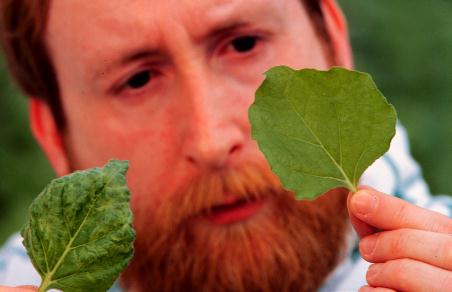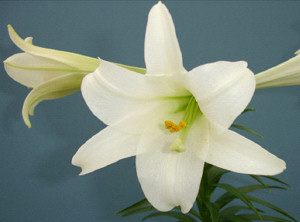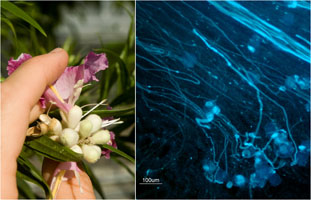


Kevin.Conrad@ars.usda.gov
|
 Dr. Donna Fare
Dr. Donna FareConducts a research program in nursery crop production with emphasis on identifying plant physiological constraints with nursery crops, developing improved production methods with field and container systems, and evaluate germplasm of ornamental trees and shrubs for landscape value.
Click here for more details
 Dr. John Hammond
Dr. John HammondConducts research on virus diseases of ornamental crops, including identification and characterization of newly occurring viruses, resistance to virus infection and replication in transgenic plants, and virus detection and strain differentiation by serology and nucleic acid hybridization. Development of a Universal Plant Virus Microarray for detection and identification of plant viruses. Click
here for more details
 Dr. Qi Huang
Dr. Qi HuangIdentifies, detects, and gains a better understanding of genetic relationships and molecular basis of pathogenicity of selected bacterial pathogens to facilitate effective control of bacterial diseases of major significance to ornamental and agronomic crops. Current research interests include: conducting research on Xylella fastidiosa including genome characterization and specific detection and identification of ornamental strains, as well as genetic relationships among ornamental and non-ornamental strains of X. fastidiosa; and improving current detection and identification methods for the select agent pathogen Ralstonia solanacearum race 3 biovar 2.
Click here for more details
 Dr. Ramon Jordan
Dr. Ramon JordanConducts research on the biochemical and biological nature of plant viruses, their genomes, and their gene products. Develops and utilizes serological and nucleic acid-based reagents and technologies for improved detection, differentiation and identification of new and emerging viruses; determines the genome organization of selected important ornamental viruses; and, develops methods and new strategies to confer virus resistance in plants through expression of antibody proteins or replicase-binding peptides in transgenic plants.
Click here for more details
 Dr. Kathryn K. Kamo
Dr. Kathryn K. KamoIdentifies biochemical
events associated with cell division and differentiation. Studies cell,
tissue and organ development and correlates biochemical changes with morphological
changes leading to formation of the whole plant. Applies biotechnology to the development
of floral bulb plants to make them resistant to viruses and nematodes. Click
here for more details
 Dr. Joseph H. Kirkbride, Jr.
Dr. Joseph H. Kirkbride, Jr.Conducts taxonomic research on the cigar tree, the
genus Catalpa of the trumpet-creeper family, and the fringe tree, the genus Chionanthus of the
olive family. Leads and joins domestic and foreign plant explorations. Responsible for, assists in
identification of fruits and seeds, and contributes to the proper curation of the U.S. National Seed Herbarium. Click here for more details
 Dr. Dilip K. Lakshman
Dr. Dilip K. LakshmanConducts research on important soil-borne fungal pathogens of ornamental plants, including Rhizoctonia solani. Current research interests include: characterization and utilization of hypovirulent isolates of R. solani for biological control and/or growth promotion of ornamental plants in the greenhouse; characterization of fungal double-stranded RNAs (dsRNAs), fungal genes and biochemical processes affecting virulence; transformation and transfection of R. solani with fungal dsRNAs; and, exploration and development of biorationals and composts as disease suppressive alternatives to methyl bromide. Click here for more details
 Dr. Richard Olsen
Dr. Richard OlsenLead scientist for the urban tree breeding and germplasm research programs at the U.S. National Arboretum. Tree breeding focuses on the development of stress-, disease-, and pest-tolerant cultivars of important landscape trees, with particular attention to native germplasm and shade trees suitable for restricted planted spaces. Over sees germplasm research that utilizes accessions in the Woody Landscape Plant Germplasm Repository (WLPGR). Objectives include the identification of important woody ornamental taxa relevant to the nursery industry, its collection, evaluation, and distribution to academic and industry research programs, and release of novel germplasm that benefits the nursery industry. Click here for more details
 Dr. Margaret Pooler
Dr. Margaret PoolerConducts basic and applied research on breeding and genetics of ornamental shrubs and small trees, including flowering cherries, redbuds, and crapemyrtles, in order to develop new cultivars that are disease and pest resistant, tolerant of environmental stresses, and have superior ornamental qualities. Breeding methodologies include traditional crosses, ploidy manipulation, in-vitro techniques, as well as using molecular markers to identify hybrids or assess genetic diversity. Click
here for more details
 Dr. Mark S. Roh
Dr. Mark S. RohConducts research on the evaluation and characterization of germplasm as part of the Woody Landscape Plant Germplasm Repository (WLPGR) project. Specific research objectives include, for example, evaluating seed germination of Cornus, Corylopsis, Eunoymous, Kolkwitzia, and Tsuga as influenced by warm/cold stratification, plant growth regulators, and maturity of seeds utilizing nuclear magnetic resonance imaging and X-ray imaging. Genetic purity of ex situ preserved germplasm of Corylopsis as well as other woody ornamental plants with horticultural merit, and characterization of germplasm such as Corylopsis and Kolkwitzia using molecular markers has been conducted. Conducted research on the utilization of pots processed from feather keratin of poultry feathers. Using the pots various compositions, growth and flowering responses in floral crop such as Begonia and Lilium and also woody plants such as Halesia and Hydrangea were evaluated. Click here for more details
 Dr. Scott Warnke
Dr. Scott WarnkeConducts research on the genetics of plants used as turfgrasses. Identifies and develops enhanced germplasm from wild species that express improved biotic and abiotic stress resistance. Develops improved turfgrasses through the use of new technologies such as molecular markers and genomics. Click here for more details
 Dr. Alan Whittemore
Dr. Alan WhittemoreResponsible for original molecular, biosystematic, taxonomic, and nomenclatural research on cultivated woody plants and their wild-occurring allies of potential scientific, economic, and landscape utility. Leads and joins domestic and foreign plant explorations. Responsible for, provides oversight of, and contributes actively to the growth and proper curation of the U.S. National Arboretum Herbarium. Click here for more details
Research Unit Home Page ||
Mission & Goals ||
History ||
Locations
Scientists & Specialties ||
Postdoctorals & Support Scientists ||
Technical & Support Staff
Recent Accomplishments ||
Publications & Patents ||
New Plant Introductions
Woody Landscape Plants Germplasm Repository ||
National Herbarium
![]()
Last Updated November 2, 2012 1:25 PM
URL = http://www.usna.usda.gov/Research/sy-info.html